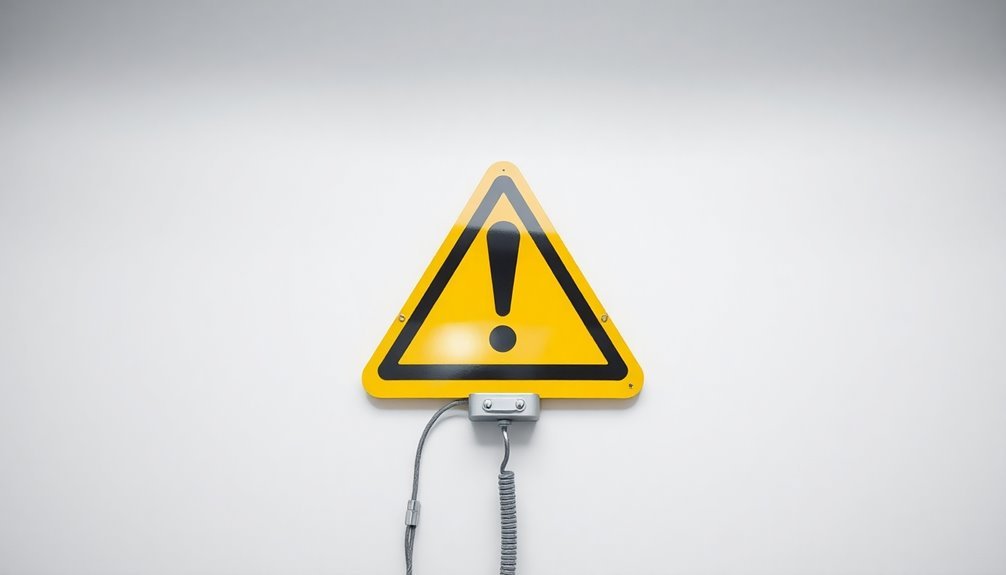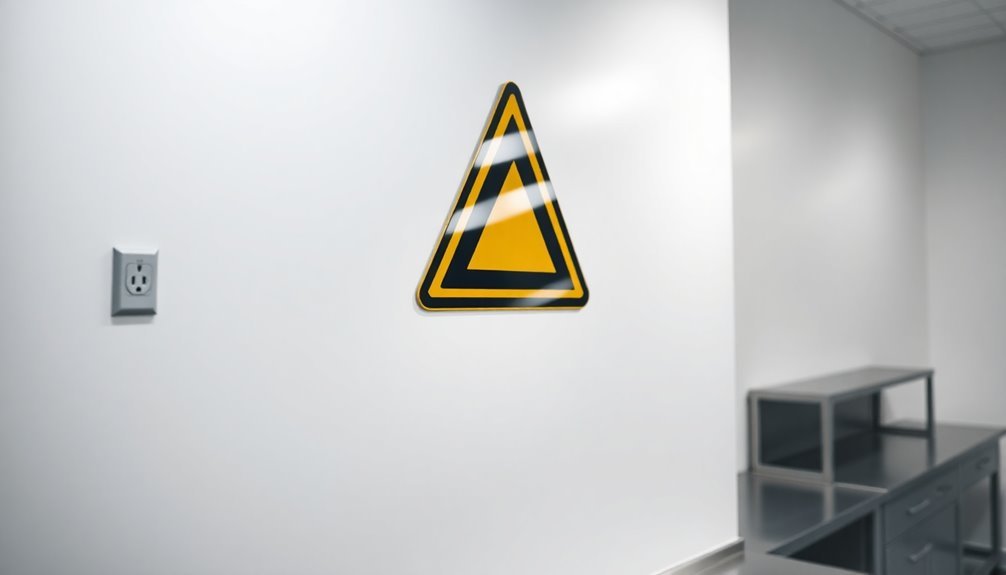You'll need five essential static control signs to maintain a safe ESD-protected workplace. Start with ESD Susceptibility Warning signs featuring the standard yellow hand symbol to identify sensitive devices. Add ESD Protected Area signs at zone boundaries to mark static-safe spaces. Install Common Ground Point markers to show where workers should connect their grounding equipment. Include Static-Safe Workstation signs that meet ANSI/ESD S8.1 requirements at assembly areas. Finally, post Personnel Grounding Requirement signs to communicate proper protective equipment usage. Understanding these critical signage requirements will help you create a thorough ESD control program.
ESD Susceptibility Warning Signs

When you're setting up ESD-protected areas in your workplace, proper warning signs are essential for safety and compliance.
You'll need to display ESD susceptibility warning signs that feature the standard symbol: a yellow hand with a slash mark inside a black triangle, typically set against a yellow background. The symbol serves to identify sensitive devices requiring special handling precautions. These signs must be clearly visible from at least three feet away and should include specific handling instructions next to the symbol.
You'll need to place these warning signs at all ESD-protected area boundaries and workstations. The signs should identify ESDS (Electrostatic Discharge Sensitive) devices and specify handling requirements.
Don't use red in your ESD signage, as it implies personnel hazards. Instead, stick to the preferred color scheme of yellow and black.
If you're working under military standards, you'll need to incorporate specific word messages and symbols like JESD471 alongside the ESD susceptibility symbol.
Remember to check your customer contracts and purchase orders for specific marking requirements. If these documents don't specify requirements, you'll need to determine marking necessities and document them in your ESD Control Program Plan.
Always verify that your signs comply with ANSI/ESD S20.20 standards.
ESD Protected Area Signs
Your facility's ESD protected area signs serve as critical visual markers to identify zones where static-sensitive components are handled. These essential signs must be clearly visible from at least three feet away and should conform to ISO 7010 standards to maintain proper static control throughout your workspace. Our American-made signs are printed on semi-gloss poster paper for maximum durability and visibility.
When implementing ESD protected area signs, you'll need to strategically place them at EPA boundaries, workstations, and multi-user environments. Consider using floor marking tape alongside your signs to define safe walkways and create thorough visual guidance within your EPA.
Key placement considerations for your ESD protected area signs include:
- Above each user bench to maintain constant awareness
- At all EPA entrance points and boundaries
- Near high-voltage areas requiring special safety precautions
- At workstations handling static-sensitive components
To guarantee compliance with standard 61340-5-1, you'll need to regularly evaluate and maintain your ESD signage. Choose from various sizes and materials, including 17"x22" or 300mm x 100mm formats, to suit your specific facility requirements.
Common Ground Point Markers

A common ground point marker serves as the central connection hub for your facility's ESD protection system. You'll need these markers to clearly identify where your ground connections are located, particularly for your 15-foot grounding cables and ESD mats that use 10mm socket snaps. These markers guarantee your team knows exactly where to connect their wrist straps and other static control equipment. The system includes polished polyurethane cords that ensure lasting durability in workplace environments.
| Marker Type | Recommended Use |
|---|---|
| Aluminum Signs | High-visibility areas with permanent mounting |
| Plastic Labels | Workstations and mobile carts |
| Magnetic Markers | Metal surfaces and adjustable locations |
| Floor Decals | Below ground points and cable routes |
| Wall Plates | Near outlet connections and test points |
When installing your ground point markers, make sure they're placed near your facility's utility "green wire" ground points or electrical outlets. You'll want to position them where they're easily visible to workers and close to ESD-protected workstations. Remember to include essential information on your markers, such as the 1 Meg Ohm resistor presence and regular testing requirements. It's vital to regularly inspect these markers and verify that the grounding points haven't become compromised due to corrosion or wear.
Static-Safe Workstation Identification Signs
Proper identification signs form the foundation of any effective static-safe workstation system. You'll need to implement clear, standardized signage that meets ANSI/ESD S8.1 requirements to protect your sensitive components and maintain a safe work environment.
The iconic ESD Susceptibility Symbol, featuring a yellow hand in a black triangle with a bar, serves as a critical warning indicator for static-sensitive areas and components. Regular safety assessments and diagnostics help ensure your ESD signage strategy remains effective and up-to-date.
For maximum effectiveness, you'll want to place signs at strategic locations throughout your facility:
- At entrances to ESD Protected Areas (EPAs) to alert personnel of required precautions
- Around individual workstations handling static-sensitive components
- Near assembly areas where ESD-vulnerable items are processed
- At component storage locations requiring special handling procedures
To maintain compliance, guarantee your signs are made of durable materials and positioned at eye level for best visibility. You'll need to conduct regular inspections to verify that all signage remains in good condition and accurately reflects current ESD control requirements.
Remember that these signs aren't just regulatory requirements – they're essential tools that reinforce your ESD training program and help protect valuable equipment from static damage.
Personnel Grounding Requirement Signs

Inside every ESD-protected workspace, personnel grounding requirement signs play a vital role in maintaining static safety protocols. You'll need to confirm these signs effectively communicate grounding requirements while following ANSI/ESD S20.20 standards for static control.
Your personnel grounding signs should feature clear, high-contrast messaging, typically using black text on yellow backgrounds. Regular evaluation and maintenance of signage helps ensure continued effectiveness of the ESD control system. Make sure they're readable from at least three feet away and include essential ESD warning symbols.
Place these signs at the boundaries of ESD-protected areas and individual workstations to remind staff about proper grounding procedures.
You'll want your signs to emphasize the use of protective equipment like wrist straps and dissipative work mats. They should also indicate the requirement for common ground points, where all equipment and personnel must connect to a central grounding conductor.
Don't forget to highlight the importance of conductive footwear in sensitive areas.
Frequently Asked Questions
How Often Should Static Control Signs Be Replaced or Inspected?
You'll need to inspect your static control signs quarterly and replace them every 7-15 years, depending on their condition. Replace them sooner if they're damaged or illegible during routine inspections.
Can Static Control Signs Lose Effectiveness if Exposed to Certain Chemicals?
Yes, your static control signs can lose effectiveness when exposed to chemicals. They'll become compromised if chemicals create insulative layers, alter conductivity, or damage anti-static coatings, reducing their ability to control static electricity.
What Temperature Ranges Can Affect the Durability of Static Control Signs?
Your static control signs' durability can be affected when temperatures fall below -40°F or rise above +180°F. For ideal performance, you'll want to keep them within this range to prevent material degradation.
Are Multilingual Static Control Signs Required in Diverse Workplace Environments?
Yes, you'll need multilingual static control signs if your workforce includes non-English speakers. OSHA requires safety signage in both English and workers' primary languages to guarantee clear communication and prevent workplace accidents.
Do Static Control Signs Need Special Cleaning Procedures to Maintain Visibility?
Yes, you'll need to use ESD-safe cleaning products and follow specific procedures to maintain static control signs. Always use a dry or slightly damp cloth and avoid harsh chemicals that could damage the sign's surface.
In Summary
You'll want to implement these five essential static control signs throughout your facility to maintain proper ESD protection protocols. By prominently displaying warning signs, protected area markers, ground points, workstation identifiers, and grounding requirements, you're creating a safer workspace and protecting sensitive equipment. Don't wait until static damage occurs – take action now to prevent costly mistakes and equipment failures.





Leave a Reply